
|
|
Avanti in ancient western Malwa was one of the Mahajanapadas and
Ujjain was the dominant urban center of that region. It was described
as a very fertile land of mild climate with a
prosperous and flourishing trade. Particular mention was made of agricultural
products, cotton crafts, a highly developed iron industry, mineral
resources, ivory, pearls, corals and precious stones. Trade routes
crossed at Ujjain connecting it closely with the other trade
centers of that time. In the 4th century BC Avanti lost its
independence being henceforth a province of the Mauryan Empire. Before he
became king himself, Asoka was appointed as viceroy of Ujjain by his
father, king Bindusara. After Asoka's death weak successors followed
him and central control soon diminished giving way to local
independence.
There are good reasons to assume that the local Ujjain copper issues
started about or shortly after 200 BC. The close affinities to the
Mauryan silver karshapanas in style, use of symbols and symbol
arrangements support this view and so does the occurrenc of the
'bale-mark' symbol on the reverses of some Ujjain coins. Of course there was a continued use of
Mauryan silver karshapanas and tiny silver/ billon masakas and some
early uninscribed cast copper types were still issued at Ujjain during
the first half of the 2nd century BCE. Western Malwa copper versions of
the Mauryan silver karshapana type GH566 (first coin below) illustrate the transition
period after which new designs were developed, frequently as an
arrangement of five different devices like on the Mauryan karshapanas
but now composed in one single die.
These die-struck local coppers appear in great numbers and in many
types- not astonishing in view of the commercial importance of the
Ujjain region, where these coppers served day to day transactions and
local trade affairs. The series was issued for a long period and
stopped only when the Satavahanas incorporated Malwa into their ever
growing empire around the middle of the 1st century BC. These coins
were extremely popular and their continued use after their production
had stopped, is suggested by association with coins of the period
100-300 CE - as it was likewise the case with Mauryan silver karshapanas
which were popular as a medium for long-distance trade and large
transactions even hundreds of years after their time of issue.
The depictions on these coins were obviously influenced by religious motifs, which were strong
elements of the cultural and social life of the people of Ujjain, like anywhere else in India. But
the main purpose of this long-lived, diverse and challenging series of
local die-struck coppers was to supply the local markets with enough
money to comply with the needs of a community so deeply involved
in commercial activities. Only one type of the series bears the
city-name, a few types bear personal names, but the vast majority are
anonymous. The characteristic reverse design, the cross with a circle
at each end, became the 'trade mark' of Ujjain coins and is thus well known
as 'Ujjain symbol', even though it also appears on many coins outside
the Ujjain region. Weights differ widely within the series from pieces
of less than 0.5g to heavy weights of 25g (the heaviest recorded
specimen offered at a public auction weighed 25.8g).
Devices frequently seen
on Ujjain coins are symbols and animals
comparable to those on other coins of ancient India. Many of such
symbols refer to different forms of nature worship among them celestial
symbols, mountains, trees, water-ponds and rivers and among the animals
bull, elephant, horse and lion occupy a prominent position. Of special
interest are human depictions as they are among India's earliest
representations of deities in anthropomorphic form and thus most
important for the iconographic development of these deities. In most
cases single human figures are depicted, standing, squatting, dancing
or sitting, representing various HIndu gods and goddesses. Different
researchers have tried to identify them and have frequently come to
divergent conclusions. The matter is not simple as in this early stage
of iconography the depiction of a deity together with its
characteristic symbols and attributes was not yet fully developed and
sometimes different deities were even associated with the same symbols.
The latest approach to the subject is Devendra Handa's brilliant paper
on 'Divinities on Ujjain Coins', ICS-NL 51, 2013' who clarified
controversies on some deities and originally proposed the
identification of others. The most prominent figure on
these coins is ceratainly Shiva Mahakala whose cult was
most important at Ujjain, and Lakshmi who experienced a
general adoration by believers of different cults who wouldn't have
hesitated to beg assistance from the goddess of wealth, prosperity and
fortune. But apart from Shiva and Lakshmi other deities are also
depicted on the coins of ancient Ujjain, such as Karttikeya, Shashthi,
Vasudhara, Krishna, Brahma and others, according to the well-founded
identifications of Devendra Handa.
|
 |
Ujjain: Early types
|

|
Maurya, punchmarked AR karshapana, 'standing Shiva type'
Weight: 3.57 gm., Dimensions: 16 x13mm.
Standing Shiva with crested hair holding danda and kamandalu; sun; six-armed symbol;
three-arched hill with crescent on top; 'bale-mark'.
'Bale-mark'
Reference: Pieper 135 (plate coin)/ GH 566
|
 |
Typologically this
Mauryan karshapana type will become an important prototype on the way
towards the 'Shiva type' of the local Ujjain coin series.
|

|
Ujjain region, punchmarked AE, 'standing Shiva type'
Weight: 2.21 gm., Dimensions: 12x11 mm.
Standing Shiva; sun; six-armed symbol; three-arched hill with crescent on top;
'bale-mark'.
'Bale-mark'.
Reference: Pieper 166 (plate coin)
|
 |
These coins are still
close copies of the silver karshapana type listed above but they are no
longer issued in silver. They still maintain the 'bale-mark' reverse
symbol of their prototype.
|

|
Ujjain, punchmarked AE, 'standing Shiva type'
Weight: 3.88 gm., Dimensions: 14 mm.
Standing Shiva holding danda and kamandalu; sun; six-aarmed symbol; tree.
'Bale-mark' and Ujjain symbol.
Reference: Pieper 164 (plate coin)
|
 |
Typologically this
type departs further from the Mauryan prototype towards the
typical local Ujjain 'Shiva type'. On that type Shiva will henceforth
occupy the dominant position to which the associated symbols are
subordinated. As can be seen below these associated symbols are
frequently still the same as on the Mauryan prototype, particularly sun
and six-armed symbol. This coin is still punchmarked in contrast to the
subsequent types which are all die-struck, but the symbol arrangement
on the coin flan is already more a composition than a randomly done
application of punches. On the reverse the 'bale-mark' is still
maintained but now it is accompanied by the Ujjain symbol. In the
further development the 'bale-mark' will disappear and the Ujjain
symbol alone will become the reverse emblem of the whole series.
|
 |
 |
 |
Ujjain: Shiva types
|
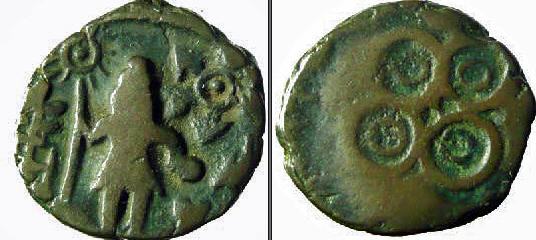
|
Ujjain, anonymous, AE 1/2 karshapana, 'standing Shiva type'
Weight: 4.94 gm., Dimensions: 16 mm.
Standing Shiva holding danda in right and kamandalu in left; sun above railed tree
on left and 6-armed symbol above taurines on right.
Double-orbed Ujjain symbol.
Reference: Pieper 265 (plate coin)/ BMC pl.XXXVIII, nos.5-6
|
 |
Devendra Handa in
'Divinities on Ujjain Coins', ICS-NL 51, p.5: "The commonest figure is
that of a male bearing matted locks or a top-knot and holding a staff
and water vessel in his two hands corresponding almost exactly to the
description of Rudra-Shiva in the Skanda Purana." The importance of the
Shiva cult at Ujjain and the combined depiction of the same figure with
a bull, the vahana of Shiva, support its identification as Shiva. |
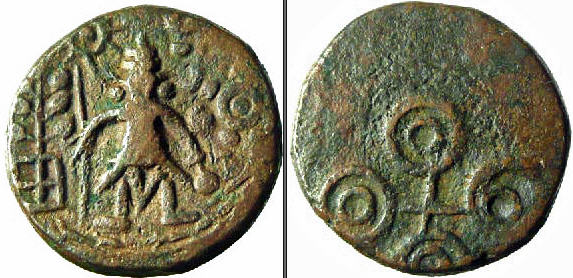
|
Ujjain, anonymous AE 3/4 karshapana, 'standing Shiva type'
Weight: 7.25 gm., Dimensions: 17 mm.
Standing Shiva holding danda in right and kamandalu in left; sun above railed tree
on left and six-armed symbol on right; taurine on top; river at bottom
Double orbed Ujjain symbol
Reference: Pieper 267 (plate coin)
|

|
Ujjain, anonymous AE 3/4 karshapana, 'standing Shiva type'
Weight: 7.22 gm., Dimensions: 17 mm.
Standing Shiva holding danda in right and kamandalu in left; sun above railed tree
on left and 6-armed symbol on right; taurine and svastika on top.
Double-orbed Ujjain symbol
Reference: Pieper 268 (plate coin)
|
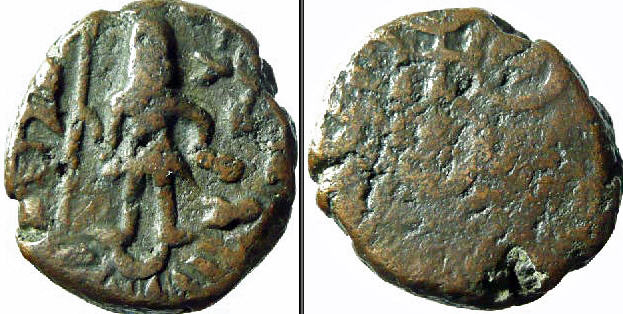
|
Ujjain, anonymous AE 1 1/2 karshapana, 'Shiva standing on lotus'
Weight: 11.99 gm., Dimensions: 18 mm.
Shiva standing on lotus holding danda in right and kamandalu in left;
railed tree on left; six-armed symbol above taurine on right.
Double-orbed Ujjain symbol
Reference: Pieper 269 (plate coin)
|
 |
The depiction of the deity with danda and kamandalu is like on the previous
coins except that the god is standing on a lotus on this specimen. |
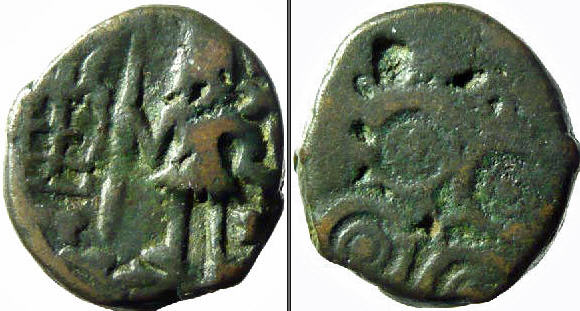
|
Ujjain, anonymous AE 1 1/2 karshapana, 'standing Shiva type'
Weight: 12.10 gm., Dimensions: 18 mm.
Shiva-like figure standing with danda in right and kamandalu on left; railed tree on
left with taurines below.
Double-orbed Ujjain symbol with an extra dot in center of each orb.
Reference: Pieper 270 (plate coin)
|
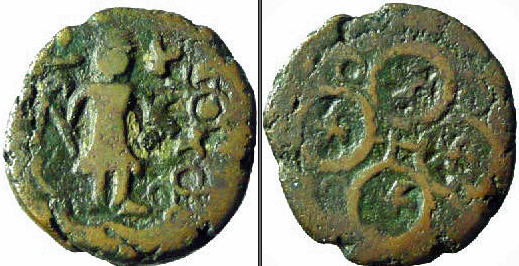
|
Ujjain, anonymous AE 1/2 karshapana, 'standing Shiva type'
Weight: 4.26 gm., Dimensions: 16 mm.
Standing Shiva holding danda and kamandalu; railed tree on left; six-armed
symbol above unconnected Ujjain symbol on right; river line at bottom.
Ujjain symbol with a svastika inside each orb and circles in the angles.
Reference: Pieper 271 (plate coin)
|

|
Ujjain, anonymous AE 3/8 karshapana, 'standing Shiva type'
Weight: 3.58 gm., Dimensions: 14 mm.
Standing Shiva holding danda and kamandalu; cakra above Indradhvaja on left;
railed tree on right; river at the botom.
Ujjain symbol
Reference: Pieper 272 (plate coin)
|
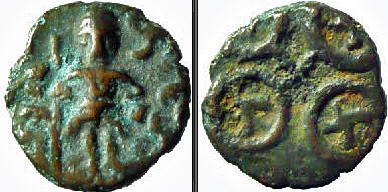
|
Ujjain, anonymous AE, 'standing Shiva type'
Weight: 1.64 gm., Dimensions: 13 mm.
Standing Shiva holding danda and kamandalu; railed tree on left; svastika on top;
cakra on right.
Ujjain symbol with a svastika in each orb.
Reference: Pieper 273 (plate coin) / BMC, pl.XXXVIII, no.10
|

|
Ujjain, anonymous AE 3/8 karshapana, 'standing Shiva-like type'
Weight: 3.34g, Dimensions: 12 mm
Standing male deity both hands akimbo, danda in right; three-arched hill above
river on left; cakra above railed tree on right.
Ujjain symbol with a svastika in each orb and footprints in angles.
Reference: Pieper 274 (plate coin) / Kothari 234 (who saw the footprints as taurines).
|
 |
The depiction of the footprint (paduka) of a deity is a well known symbol of
worship but it allows no attribution to a specific deity, as this symbol was used
by followers of different deities, among them Buddha, Shiva and Vishnu.
|

|
Ujjain, anonymous AE 1/4 karshapana, 'dancing Shiva type'
Weight: 2.35 gm., Dimensions: 13 mm.
Shiva in dancing pose with both knees slightly bent holding curved club-like
danda and kamandalu; river on left; leaves of a tree on right.
Double orbed Ujjain symbol with crescents in angles.
Reference: Pieper 275 (plate coin)
|
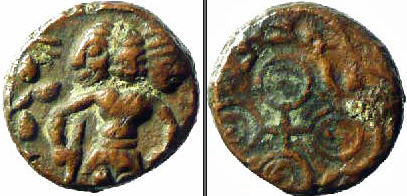
|
Ujjain, anonymous AE 1/4karshapana, 'poly-cephalous Shiva type'
Weight: 2.65 gm., Dimensions: 12 mm.
Multi-headed Shiva holding danda and kamandalu; tree on left; (cakra above
fish-tank on right)
Double orbed Ujjain symbol surrounded by river with fish.
Reference: Pieper 276 (plate coin) / BMC, pl. XXXVIII, no.19
|

|
Ujjain, anonymous AE 1/2 karshapana, 'poly-cephalous Shiva type'
Weight: 4.32 gm., Dimensions: 17 mm.
Multi-headed standing Shiva holding danda and kamandalu; railed tree on right;
cakra above fish-tank on left.
Double orbed Ujjain symbol.
Reference: Pieper 280 (plate coin) / BMC, pl.XXXVIII, no.22
|
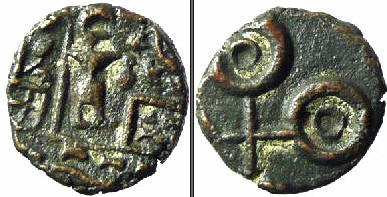
|
Ujjain, anonymous AE, 'crested standing Shiva type'
Weight: 1.82 gm., Dimensions: 12 mm.
Crested Shiva standing to right; railed tree on left; cakra above fish-tank on left;
river at the bottom.
Double-orbed Ujjain symbol.
Reference: Pieper 281 (plate coin) / BMC, pl.XXXVIII, no.14
|
 |
In contrast to the
above listed coins with depictions of Shiva with a top-knot hairdress,
the hairstyle of the 'crested Shiva type' is depicted in a ponytail
fashion thus reflection the 'matted locks' of Shiva as described in
ancient texts.
|
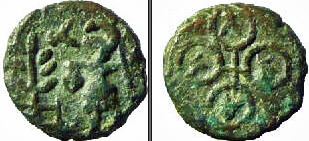
|
Ujjain, anonymous AE, 'crested standing Shiva type'
Weight: 0.72 gm., Dimensions: 9 mm.
Crested Shiva standing to left holding danda and kamandalu; railed tree on left;
taurine on top.
Ujjain symbol with alternating svastikas and taurines in its orbs.
Reference: Pieper 282 (plate coin) / BMC, pl.XXXVIII, nos. 11-12
|

|
Ujjain, anonymous AE, 'Shiva-like figure holding kamandalu before breast'
Weight: 1.10 gm., Dimensions: 10 mm.
Shiva-like standing figure holding danda and kamandalu; taurine above standard
on left.
Ujjain symbol
Reference: Pieper 284 (plate coin)
|
 |
The unusual feature of this coin is the position of the kamandalu which appears to be held by the
standing deity just in front of its breast.
|
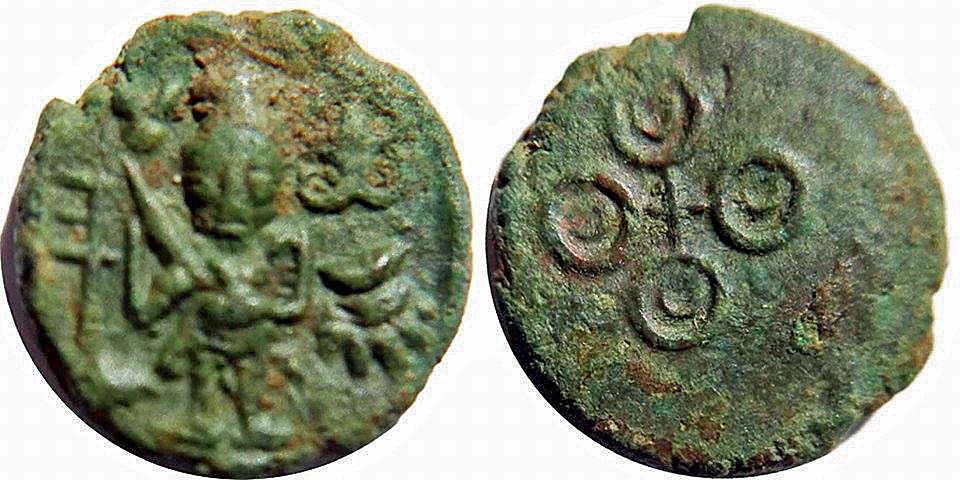
|
Ujjain, anonymous AE, 'Shiva-like figure holding kamandalu before breast'
Weight: 1.2 gm., Dimensions: 11 mm.
Shiva-like standing figure holding danda and kamandalu; taurine above standard on left,
srivatsa above a lotus-like symbol at right
Double-orbed Ujjain symbol
Reference: Pieper 284
|
 |
This beautifully preserved specimen clearly confirms that the deity is indeed holding
a kamandalu in front of the breast. (Photo courtesy Prakash Jinjuvadiya.)
|

|
Ujjain, anonymous AE, 'standing Shiva type'
Weight: 1.72 gm., Dimensions: 12x11 mm
Standing Shiva holding danda and kamandalu; six-armed symbol on top.
Ujjain symbol.
Reference: Pieper 287 (plate coin)
|
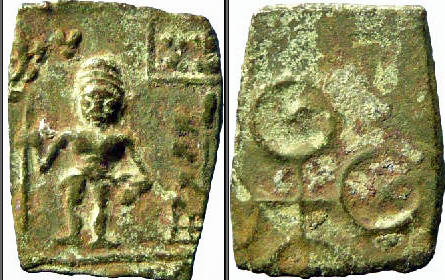
|
Ujjain, anonymous AE 3/8 karshapana, 'standing Shiva type'
Weight: 3.16 gm., Dimensions: 18x14 mm.
Standing Shiva holding danda and kamandalu; cakra above svastika and standard
on left; fish-tank above railed tree on right; river at the bottom.
Ujjain symbol with a svastika in each orb.
Reference: Pieper 289 (plate coin) / BMC, pl.XXXVII, nos.19-20
|
 |
A very artistic and detailled depiction of Shiva in his ascetic form.
|
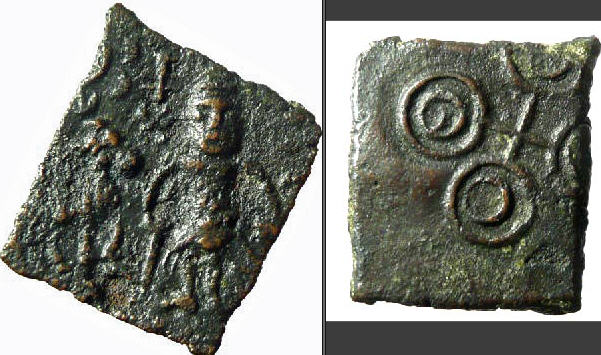
|
Ujjain, anonymous AE 3/8 karshapana, 'standing Shiva + nandi type'
Weight: 3.18 gm., Dimensions: 18x16 mm.
Standing Shiva holding danda and kamandalu, nandi facing from left towards the
deity; cakra and standard on top left.
Double-orbed Ujjain symbol.
Reference: Pieper 319 (plate coin)
|
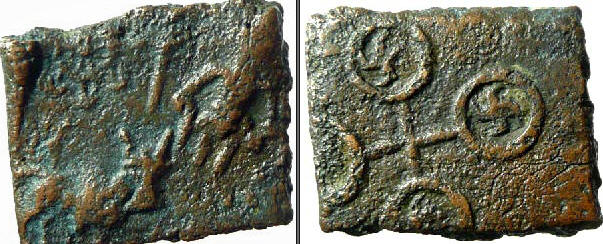
|
Ujjain, anonymous AE 1/2 karshapana, 'standing Shiva + nandi type'
Weight: 5.03 gm., Dimensions: 17x15 mm.
Standing Shiva holding danda and kamandalu, nandi on the left facing towards the
viewer; cakra and Indradhvaja on top; parts of tree on right.
Ujjain symbol with a svastika in each orb.
Reference: Pieper 318 (plate coin)
|

|
Ujjain, anonymous AE 1/2 karshapana, 'standing Shiva + nandi type'
Weight: 5.31 gm., Dimensions: 17x17 mm.
Standing Shiva on right with nandi on left facing towards the deity; railed tree in
center between Shiva and bull.
Ujjain symbol.
Reference: Pieper 321 (plate coin)
|

|
Ujjain, anonymous AE 2 karshapana, 'standing Shiva + nandi type'
Weight: 15.53 gm., Dimensions: 26x21 mm.
Standing Shiva on right with nandi on left facing towards the deity; railed tree in
center between Shiva and bull; taurines on top and a svastika on right bottom;
river with diverse aquatic creatures at the bottom.
Double-orbed Ujjain symbol with an extra arm topped by a taurine in each angle.
Reference: Pieper 322 (plate coin)
|
 |
An unusual heavy
weight standard for the series. The heaviest recorded specimen offered
at a public auction weighed 25.8 gm thus roughly representing a triple
copper karshapana.
|
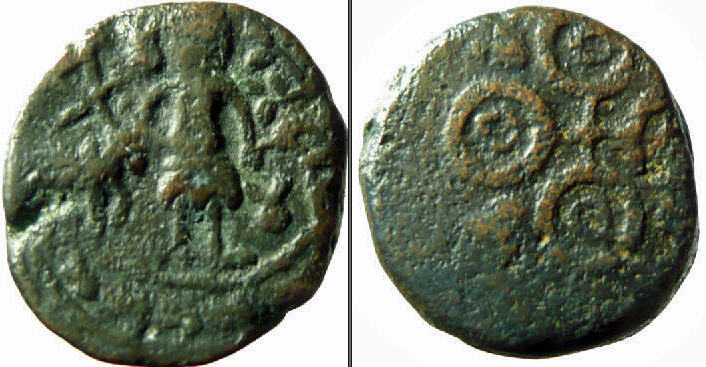
|
Ujjain, anonymous AE 1 1/2 karshapana, 'standing Shiva + nandi type'
Weight: 13.38 gm., Dimensions: 20 mm.
Standing Shiva in center; bull facing the deity from left, Indradhvaja above the bull;
railed tree on right; river at the bottom.
Double-orbed Ujjain symbol with a taurine in each angle.
Reference: Pieper 313 (plate coin)
|

|
Ujjain, anonymous AE 1/2 karshapana, 'standing Shiva+ nandi type'
Weight: 3.40 gm., Dimensions: 18 mm.
Standing Shiva holding danda and kamandalu; bull facing the deity from the right;
Ujjain symbol on top; railed tree on left; river at the bottom.
Ujjain symbol with a svastika in each orb.
Reference: Pieper 311 (plate coin)
|
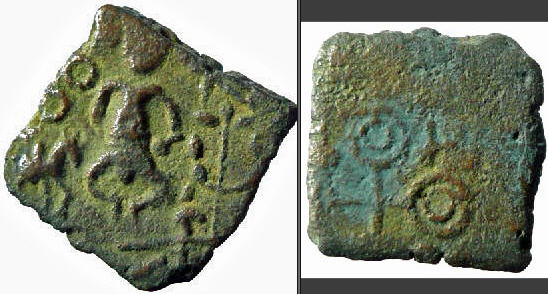
|
Ujjain, anonymous AE 3/8 karshapana, 'seated Shiva + nandi type'
Weight: 3.44 gm., Dimensions: 14x14 mm.
Seated Shiva holding danda and kamandalu; bull facing the deity from left; Ujjain symbol
above the bull; railed tree on right; river at the bottom.
Double-orbed Ujjain symbol with a taurine in each angle.
Reference: Pieper 307 (plate coin)
|
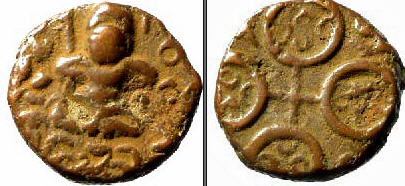
|
Ujjain, Bhumimitra AE, 'seated Lakulisha type'
Weight: 1.78 gm., Dimensions: 12 mm.
Lakulisha seated on a lotus holding danda and kamandalu; cakra above tree on left;
Brahmi legend 'bhumimitasa' in vertical placement on right.
Ujjain symbol with a small Ujjain symbol in each orb; nandipadas in angles.
Reference: Pieper 405 (plate coin)
|
 |
The seated figure on
this coin type has been identified as Lakulisha by several scholars,
among them Wakankar, Kothari and Bhatt. Lakulisha is described as
the 28th and last incarnation of Shiva. He propagated and reformed Shaivism with
special emphasis on Yoga practices. According to Handa (ICS-NL 51,
p.24)"the god depicted here predates the textual prescriptions and is one of the
earliest examples of the depiction of Lakulisha. Alternatively it may
be said to be the representation of Yogeshvara Shiva."
|

|
Ujjain, inscribed AE 1/3 karshapana, elephant type
Weight: 2.93 gm., Diameter: 13x13 mm
Obv.: In a square incuse elephant standing to right with raised trunk; Brahmi
legend around reading anti-clockwise with outwards directed letters
'bhumimitasa'.
Rev.: Double-orbed Ujjain symbol with a taurine in each angle.
Reference: Pieper 407 (plate specimen)
|
 |
The 'seated
Lakulisha type' inscribed in the name of Bhumimitra is a well known
type among the rare inscribed coins of the local Ujjain series. This
square elephant type inscribed in the same name Bhumimitra was
completely unknown until the appearance of this unique specimen.
|
 |
 |
 |
More Ujjain Coins: page 2,
page 3, and
page 4,
|
|
|